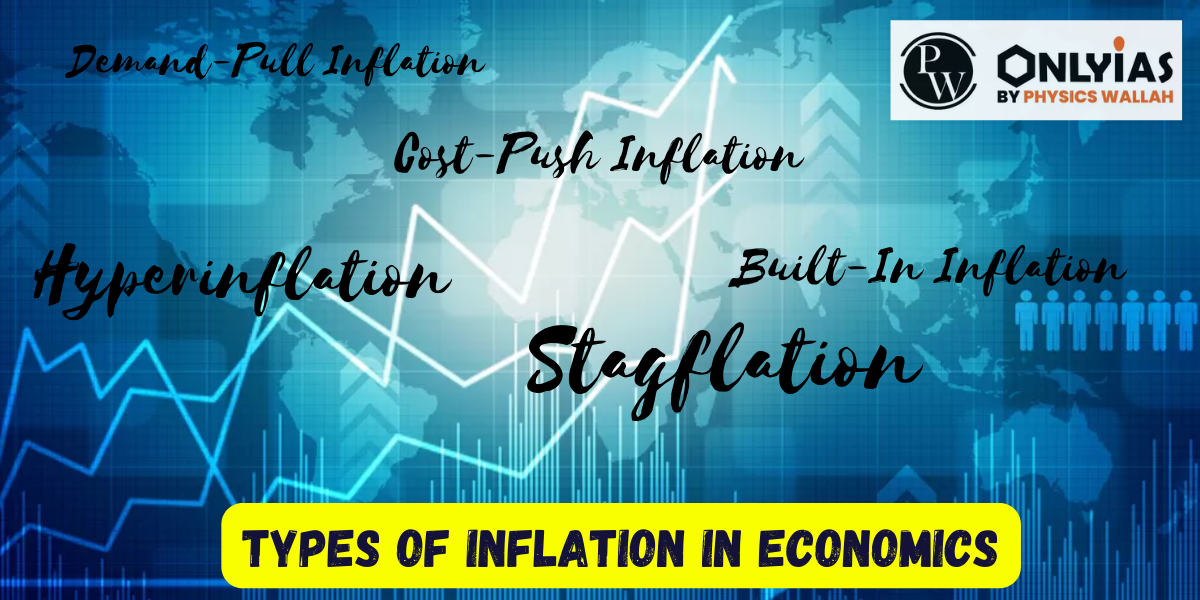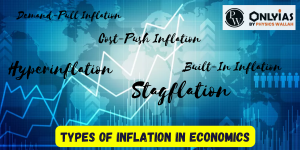
Inflation is a critical economic concept that refers to the increase in the general price level of goods and services over time. It is measured by the rate of change in the Consumer Price Index (CPI) or the Wholesale Price Index (WPI).
Inflation can have significant implications for the economy, affecting everything from consumer purchasing power to business investments. In this article we will learn about the Various types of Inflation in Economics.

Inflation refers to the gradual rise in the prices of goods and services within an economy, leading to a decrease in the purchasing power of money over time. In simple terms, it means that the same amount of money can buy fewer goods than it could in the past. For instance, if the inflation rate is 2%, a $10 item purchased last year will cost $10.20 this year.
Several factors can trigger inflation, including an expansion in the money supply, a decrease in the availability of goods, or an upsurge in demand for goods and services.
These factors can disturb the delicate balance between supply and demand, resulting in a general increase in prices across the economy. Inflation has significant implications for consumers, businesses, and policymakers, as it impacts purchasing power, interest rates, and economic stability.
To understand the various effects of inflation, it is essential to explore the different types of inflation. In this article, we will delve into the various forms of inflation, their causes, and their impact on the economy.
Inflation is an economic term that refers to the general increase in prices of goods and services over a period of time, resulting in a decrease in the purchasing power of money. In other words, as inflation occurs, each unit of currency buys fewer goods or services than it did before.
However, high or hyperinflation, which involves extremely rapid and uncontrollable increases in prices, can have severe negative consequences, such as eroding savings, reducing the standard of living, and creating economic instability.
Central banks and monetary authorities often aim to maintain a target level of inflation to strike a balance between economic growth and price stability.

Inflation, a key concept in economics, refers to the general increase in prices of goods and services over time, eroding the purchasing power of money. Understanding the different types of inflation is crucial for policymakers, businesses, and individuals to navigate the complexities of the economy.
We will explore the various forms of inflation and their underlying causes, ranging from moderate and manageable price rises to hyperinflation, which can lead to severe economic repercussions.
Each type of inflation presents unique challenges and implications for different stakeholders, making it essential to grasp their distinct characteristics to make informed economic decisions. Let’s delve into the world of inflation and its multifaceted nature.
In economics, inflation can manifest in various forms, each driven by distinct factors within an economy. These types of inflation are a consequence of fluctuations in demand, supply, or imbalances in economic conditions. Below is a comprehensive explanation of the various types of inflation in economics.
Following table depicts the overview of the Types of Inflation in Economics:
Types of Inflation in Economics Overview |
||
|---|---|---|
| Types of Inflation | Description | Example |
| Demand-Pull Inflation | Occurs when demand for goods and services exceeds supply, leading to rising prices. | Economic boom leads to increased consumer spending. |
| Cost-Push Inflation | Arises when production costs increase, causing businesses to raise prices. | Rising oil prices increase transportation costs. |
| Built-In Inflation | A cycle where higher wages lead to higher prices, and vice versa. | Workers demand wage hikes due to rising living costs. |
| Hyperinflation | Extreme and uncontrollable rise in prices, causing currency devaluation. | Zimbabwe experienced hyperinflation in late 2000s. |
| Stagflation | High inflation combined with stagnant economic growth and unemployment. | Economic downturn with rising prices and job losses. |
| Open Inflation | Inflation openly acknowledged and known to all stakeholders. | Economic prosperity with transparent price increases. |
| Suppressed Inflation | Official inflation rate artificially kept low through government intervention. | Government controls prices to maintain stability. |
Inflation, an essential economic concept, refers to the general increase in the price level of goods and services over time. It erodes the purchasing power of money and can significantly impact economies, businesses, and individual consumers.
Understanding inflation is crucial for policymakers and investors alike, as it influences interest rates, wages, investment decisions, and overall economic stability.
There are various types of inflation, each characterized by different underlying causes and implications. This article explores the fundamental types of inflation, shedding light on their distinguishing features and potential consequences.
By delving into these different forms, we can gain a deeper comprehension of the complex forces driving price fluctuations in the ever-evolving world of economics.
Following are the types of Inflations in detail:
Understanding the various types of inflation is essential for policymakers, businesses, and consumers alike. Different forms of inflation can have distinct impacts on the economy, affecting economic growth, purchasing power, and the overall standard of living.
Managing inflation is a delicate balancing act for policymakers, who must consider various economic indicators and adopt appropriate monetary and fiscal policies to ensure stable and sustainable economic growth.
As inflation remains a critical aspect of the economic landscape, being aware of its different manifestations is crucial for making informed financial decisions and navigating the economic challenges of the future.

Inflation is a critical economic indicator with wide-ranging effects on the economy. For UPSC aspirants, having a clear understanding of the various types of inflation and their causes is vital.
This knowledge enables candidates to analyze economic policies and their impact on inflation, making it an essential topic for both the Prelims and Mains exams. Additionally, familiarity with this subject is valuable during UPSC interviews.
There are four distinct types of inflation categorized by speed: hyperinflation, galloping, walking, and creeping. Hyperinflation occurs when the inflation rate reaches an extraordinary level, such as 50% per month. This phenomenon is extremely rare and has been observed in specific instances, including recent examples in Venezuela, Zimbabwe during the 2010s, and Germany in the 1920s.
There are no specific "7 types of inflation" as a standard classification. Inflation is generally categorized based on its speed or rate of increase. The common classifications include: Hyperinflation: This is an extremely high and typically accelerating rate of inflation. It results in the rapid devaluation of a country's currency, leading to a loss of confidence in the monetary system. Galloping Inflation: Galloping inflation refers to a very high inflation rate, although not as extreme as hyperinflation. Prices rise rapidly, leading to a decrease in the purchasing power of money. Walking Inflation: Walking inflation represents a moderate and steady increase in the general price level, typically around 3-10% annually. It is more controlled compared to galloping inflation. Creeping Inflation: Creeping inflation refers to a mild and gradual increase in the general price level, usually within the range of 1-3% annually. It is considered manageable and may even be targeted by central banks to support economic growth. Open Inflation: This occurs when the general public is aware of the rising prices and inflationary pressures. Suppressed Inflation: Suppressed inflation occurs when the government implements price controls or other measures to keep inflation artificially low. This may result in shortages and distortions in the economy. Repressed Inflation: Repressed inflation is similar to suppressed inflation, but it occurs when the government uses financial repression, such as keeping interest rates below inflation, to manage debt.
The two main types of inflation are: 1. Demand-Pull Inflation: Demand-pull inflation occurs when there is an increase in aggregate demand in an economy that outpaces the economy's ability to supply goods and services. This situation often arises when consumer spending increases, government spending rises, or there is a surge in private investment. The excess demand causes prices to rise, leading to inflation. 2. Cost-Push Inflation: Cost-push inflation happens when the costs of production for goods and services increase, leading to higher prices. This can occur due to various factors, such as rising raw material prices, increased labor costs, higher taxes or tariffs, and supply chain disruptions. When businesses face higher production costs, they pass on these expenses to consumers by raising prices, resulting in cost-push inflation.
Four common causes of inflation are: Demand-Pull Inflation: This occurs when the demand for goods and services in an economy exceeds its supply. When consumers have more money to spend, and businesses cannot meet the increased demand, they raise prices, leading to inflation. Cost-Push Inflation: Cost-push inflation occurs when the cost of production for goods and services increases. Factors such as rising wages, higher raw material prices, or increased production costs can force businesses to raise prices to maintain their profit margins, causing inflation. Built-In Inflation: This type of inflation results from an economy's expectations of future price increases. For example, workers may demand higher wages to keep up with expected inflation, leading to a cycle of increasing prices and wages. Monetary Inflation: Also known as demand-induced inflation, monetary inflation happens when there is an increase in the money supply in the economy, either through central bank actions or excessive government borrowing. When more money is available, it can lead to higher spending, which, in turn, can drive up prices.
WPI (Wholesale Price Index) and CPI (Consumer Price Index) are two different measures of inflation. While WPI gauges inflation at the business level, CPI reflects inflation at the consumer level. WPI primarily tracks prices of goods exchanged between business entities, while CPI focuses on prices of goods purchased by consumers.
<div class="new-fform">
</div>
